Atkinson K. An Introduction to Numerical Analysis
Подождите немного. Документ загружается.

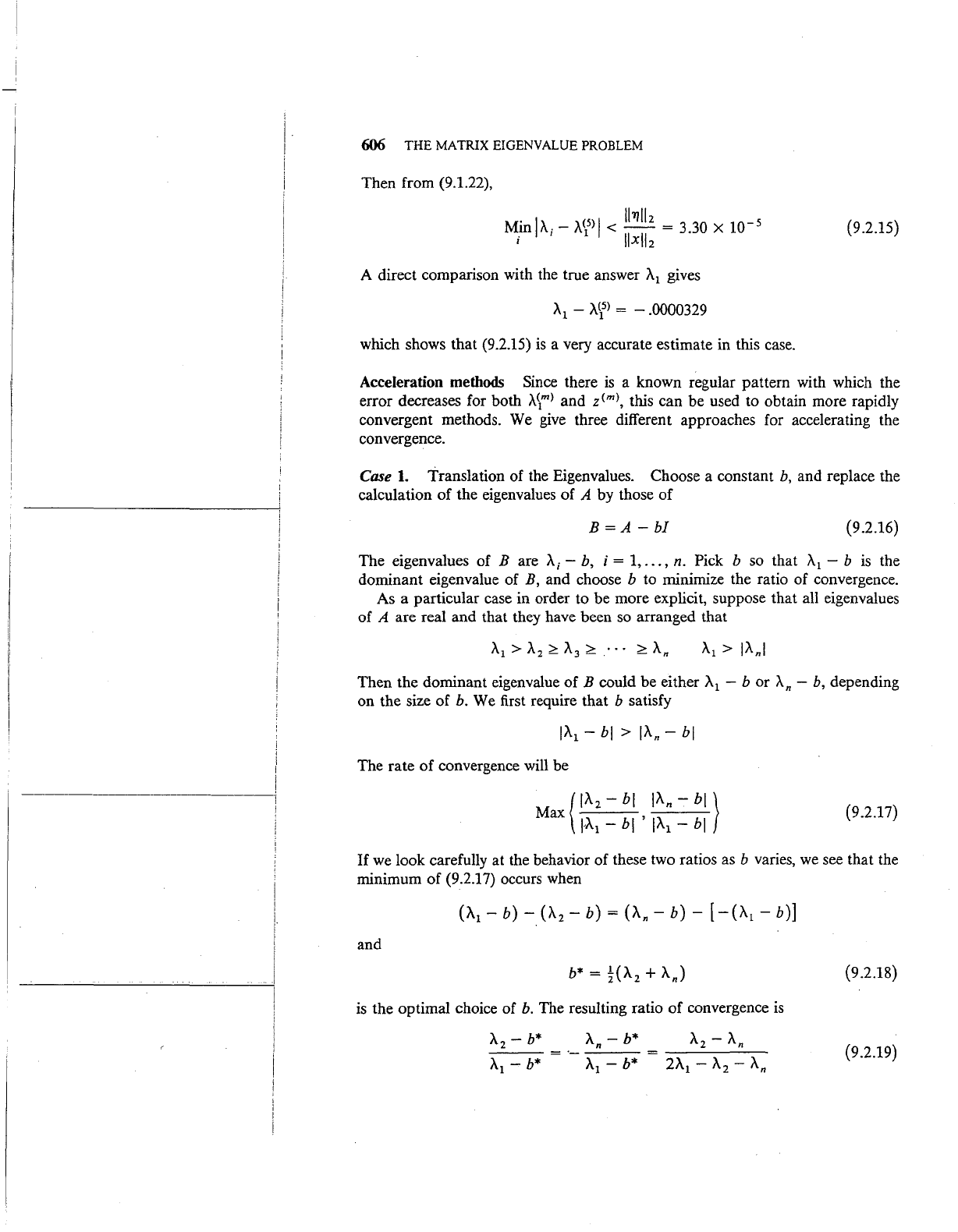
I
I
i
i
I
I
606
THE
MATRIX EIGENVALUE PROBLEM
Then from (9.1.22),
Min
ji\.-
i\<
5
>j
<
ll'11ll
2
= 3 30 X
10-
5
; '
1
llxll2
·
(9.2.15)
A direct comparison with the true answer
i\
1
gives
i\1
-
i\~)
= - .0000329
which shows that (9.2.15)
is
a very accurate estimate in this case.
Acceleration methods Since there
is
a known regular pattern with which the
error decreases for both
i\\m>
and
z<m>,
this can be used to obtain more rapidly
convergent methods. We
give
three different approaches for accelerating the
convergence.
Case
1.
Translation of the Eigenvalues. Choose a constant b, and replace the
calculation of the eigenvalues of
A by those of
B
=A-
bl
(9.2.16)
The eigenvalues of
B are
A;-
b, i = 1,
...
, n. Pick b so that
i\
1
- b
is
the
dominant eigenvalue of
B, and choose b to minimize the ratio of convergence.
As a particular case in order to be more explicit, suppose that all eigenvalues
of
A are real and that they have been
so
arranged that
Then the dominant eigenvalue of
B could be either
i\
1
- b or
i\n-
b,
depending
on the size of
b. We first require that b satisfy
The rate
of
convergence will be
(9.2.17)
If
we
look carefully at the behavior of these two ratios as b varies,
we
see that the
minimum of (9.2.17) occurs when
(i\1-
b)-
(i\2-
b)=
(i\n-
b)-
[
-(i\1-
b)]
and
b*
=
l(i\
+
i\.
)
2 2 n
is
the optimal choice of
b.
The resulting ratio
of
convergence
is
An-
b*
i\.1-
b*
(9.2.18)
(9.2.19)
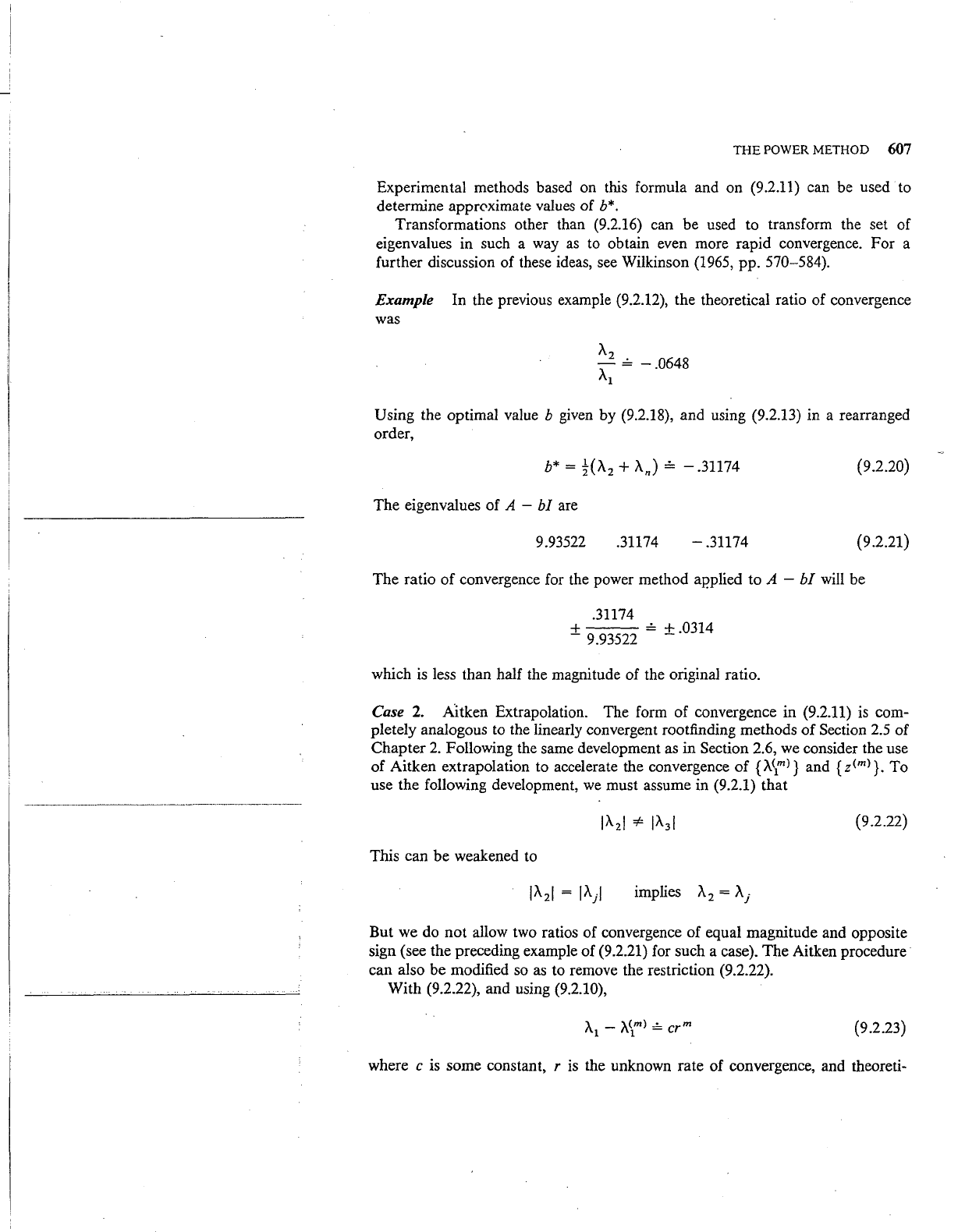
THE
POWER METHOD
607
Experimental methods based on
th.is
formula and on (9.2.11) can be used to
determine
apprcximate values of b*.
Transformations other than (9.2.16) can be used to transform the set of
eigenvalues in such a
way
as
to obtain even more rapid convergence. For a
further discussion of these ideas, see Wilkinson
(1965, pp. 570-584).
Example In the previous example (9.2.12), the theoretical ratio of convergence
was
A.
/
~
-.0648
1
Using the optimal value b given by (9.2.18), and using (9.2.13) in a rearranged
order,
b*
= t(A.
2
+ A.J
~
-.31174
(9.2.20)
The eigenvalues of A -
bl
are
9.93522 .31174
-.31174
(9.2.21)
The ratio of convergence for the power method
aJ?plied
to A -
bl
will
be
.31174
± 9.93522
~
± "
0314
which
is
less than half the magnitude of the original ratio.
Case
2.
Aitken Extrapolation. The form of convergence in (9.2.11)
is
com-
pletely analogous to the linearly convergent rootfinding methods of Section
2.5 of
Chapter
2.
Following the same development as in Section 2.6,
we
consider the use
of Aitken extrapolation to accelerate the convergence
of
{
A.<tl}
and {
z<ml
}.
To
use the following development,
we
must assume in (9.2.1) that
(9.2.22)
This can be weakened to
But we do not allow two ratios of convergence of equal magnitude and opposite
sign (see the preceding example of
(9.2.21) for such a case). The Aitken procedure
can also be modified
so
as
to remove the restriction (9.2.22).
With (9.2.22), and using (9.2.10),
(9.2.23)
where c is some constant, r
is
the unknown rate of convergence, and theoreti-

I
----j
i
I
l
I
I
I
I
I
608
THE
MATRIX EIGENVALUE PROBLEM
cally r = A :z!i\. Proceeding exactly as in Section 2.6, implies that
as
m-+
oo
(9.2.24)
And
Aitken extrapolation
gives
the improved value
~
1
:
m
~
3 (9.2.25)
A similar derivation can
be
applied to the eigenvector approximants, to accel-
erate each component of the sequence
{z(m)},
although some care must be used.
Exampk
Consider again the example (9.2.12).
In
Table 9.1,
A2
R
5
=
-.06474
=
~
=
-.06479
1
As
an
example
of
(9.2.25), extrapolate with the values
A?\
)..~),
and
A.\
4
)
from that
table.
Then
~1
= 9.6234814
A.
1
-
~
1
=
-6.03
X
10-
6
In
comparison using the more accurate table value
A.?).
the error is A
1
-A.?)=
-3.29
X
10-
5
•
This again shows the value
of
using extrapolation whenever the
theory justifies its use.
Case 3.
The
Rayleigh-Ritz Quotient. Whenever A is symmetric,
it
is better to
use the following eigenvalue approximations:
(Az(m),
z(m))
(w<m+1),
z(m))
A_(m+
1)
= =
_..:._
___
_:_
1
(z<m),
z(m))
(z<m),
z(m))
We are using standard inner product notation:
n
(w,
z) = .[w;z;
1
w, z E
R"
m~O
(9.2.26)
To
analyie
this sequence (9.2.26), note that all eigenvalues
of
A are real and
that the eigenvectors x
1
,
•••
, xn can
be
chosen to
be
orthonormal.
Then
(9.2.2),
(9.2.4), (9.2.5), together with (9.2.26), imply ·
n
L
laji2A~m+1
A_<;"+
1)
= -=-j--.:..!----
.E
la)2A_~m
j=l
(9.2.27)

...
i"
ORTHOGONAL TRANSFORMATIONS USING HOUSEHOLDER MATRICES 609
The ratio of convergence of
A.\m>
to
A.
1
is
(A.:z!A.
1
)
2
,
an improvement on the
original ratio in
(9.47) of
A.:z!A.
1
•
This
is
a well-known classical procedure, and it has many additional aspects
that are of use in some problems. For additional discussion, see Wilkinson
(1965,
pp. 172-178).
Example
In the example (9.2.12), use the approximate eigenvector
z<
2
> in
(9.2.26). Then
which is as accurate
as
the value
A.?>
obtained earlier.
The power method can be used when there
is
not a single dominant eigen-
value,
but
the algorithm
is
more complicated. The power method can also be used
to determine eigenvalues other than the dominant one. This involves a process
called
deflation of A to remove
A.
as an eigenvalue.
For
a complete discussion of
all aspects
of
the power method, see Golub and Van Loan (1983, 208-218) and
Wilkinson
(1965, chap. 9). Although it is a useful method in some circumstances,
it should be stressed that the methods of the following sections are usually more
efficient.
For
a rapidly convergent variation on the power method and the
Rayleigh-Ritz quotient, see the
Rayleigh quotient iteration for symmetric matrices
in
Parlett (1980, p. 70).
9.3 Orthogonal Transformations Using
Householder Matrices
As one step in finding the eigenvalues of a matrix, it is often reduced to a simpler
form using similarity transformations. Orthogonal matrices will be the class of
matrices we use for these transformations.
It
was shown
in
(9.1.39) that orthogo-
nal transformations
will not worsen the condition or stability of the eigenvalues
of
a nonsymmetric matrix. Also, orthogonal matrices have other desirable error
propagation properties, an example of which is given later in the section. For
these reasons,
we
restrict our transformations to those using orthogonal matrices.
We begin the section by looking
at
a special class of orthogonal matrices
known as
Householder matrices. Then
we
show how to construct a Householder
matrix that will transform a given vector to a simpler form. With this construc-
tion as a tool,
we
look at two transformations of a given matrix A:
(1)
obtain its
QR
factorization, and (2) construct a similar tridiagonal matrix when A
is
a
symmetric matrix. These forms are used in the next two sections in the calcula-
tion of the eigenvalues of
A. As a matter of notation, note that
we
should be
restricting the use of the term orthogonal to real matrices. But it has become
common usage in this area
~o
use orthogonal rather than unitary for the general
complex case, and
we
will adopt the same convention. The reader should
understand
unitary when
ort7gonal
is
used for a complex matrix.
Let w
E
en
with
Uwlb
=
w*w
= 1. Define
U=
1-
2ww*
This is the general form of a
Householder matrix.
(9.3.1)

I
---~--------------------,
I
I
610
THE
MATRIX EIGENVALUE PROBLEM
Example
For
n =
3,
we
require
The matrix
U
is
given by
[
1-
21wtl
2
U = -2M.\w
2
-2w
1
w
3
For
the particular case
we
have
-2w
1
w
2
1 -
21w
2
1
2
-2w
2
w
3
U=
~[
-~
9
-4
-4
1
-8
-4]
-8
1
We first prove U
is
Hermitian and orthogonal.
To
show it
is
Hermitian,
U*
=
(1-
2ww*)*
=I*
- 2(
ww*)*
= I - 2(
w*)*w*
= I - 2 ww* = U
To
show
it
is orthogonal,
U*U = U
2
=
{1-
2ww*)
2
=
I-
4ww* +
4{
ww*)(
ww*)
=I
since using the associative law and w*w = 1 implies
{ ww*)( ww*) =
w{
w*w)
w*
= ww*
The matrix U of the preceding example illustrates these properties. In Problem
12,
we
give a geometric meaning
to
the linear function
T(x)
= Ux for U a
Householder matrix.
We
will usually use vectors w with leading zero components:
w = [0,
...
,
o.
w,,
...
,
w,F
= [0,_
1
,
wry
(9.3.2)
with
WE
cn-r+l.
Then
U=
[I,
0
_t
0 ]
In-r+l
-
2ww*
(9.3.3)
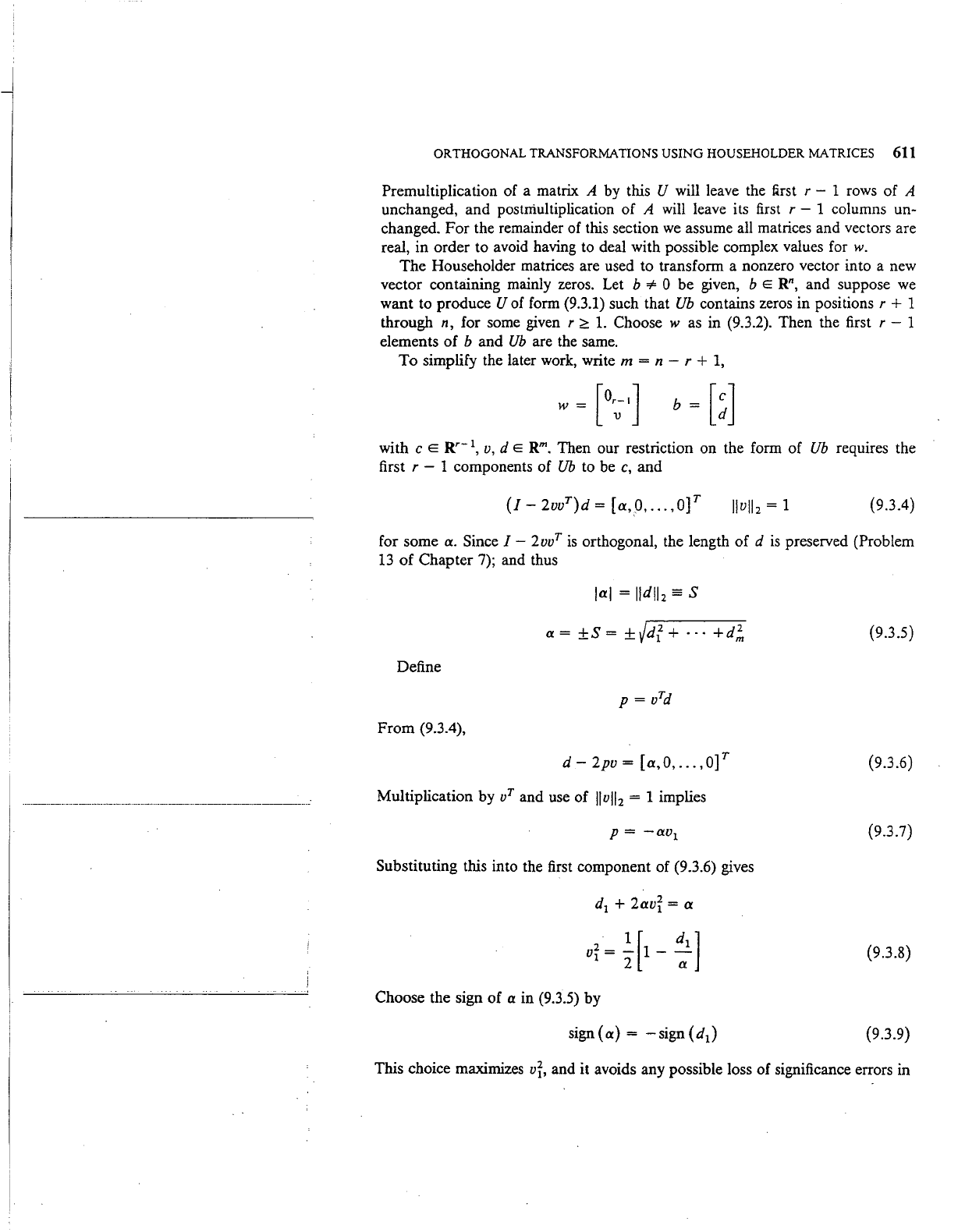
ORTHOGONAL TRANSFORMATIONS USING HOUSEHOLDER MATRICES
611
Premultiplication of a matrix A by this U will leave the
Rrst
r - 1 rows
of
A
unchanged, and postniultiplication
of
A will leave its first r - 1 columns un-
changed.
For
the remainder of this section
we
assume all matrices and vectors are
real,
in
order to avoid having to deal with possible complex values for
w.
The
Householder matrices are used to transform a nonzero vector into a new
vector containing mainly zeros. Let b * 0
be
given, b E
Rn,
and suppose we
want to produce U of form (9.3.1) such that
Ub
contains zeros in positions r + 1
through n, for some given r
~
L Choose w as in (9.3.2). Then the first r - 1
elements
of
b
and
Ub
are the same.
To
simplify the later work, write m =
n-
r + 1,
with c E
Rr-l,
v,
dE
Rm.
Then our restriction on the form
of
Ub
requires the
first r - 1 components
of
Ub
to be
c,
and
(I-
2vvT)d = [ a,O,
...
,
Of
(9.3.4)
for some a. Since
I-
2vvT
is
orthogonal, the length
of
d
is
preserved (Problem
13
of
Chapter
7); and thus
a=
+S
= +
Vd
2
+ · · ·
+d
2
- - 1 m
(9.3.5)
Define
From
(9.3.4),
d-
2pv=
[a,O,
...
,O]T
(9.3.6)
Multiplication by
vT
and use
of
llvll
2
= 1 implies
(9.3.7)
Substituting this into the first component of (9.3.6) gives
d
1
+
2avi
=a
(9.3.8)
Choose the sign
of
a in (9.3.5)
by
sign
(a)
= - sign ( d
1
)
(9.3.9)
This choice maximizes vi, and it avoids any possible loss
of
significance errors in
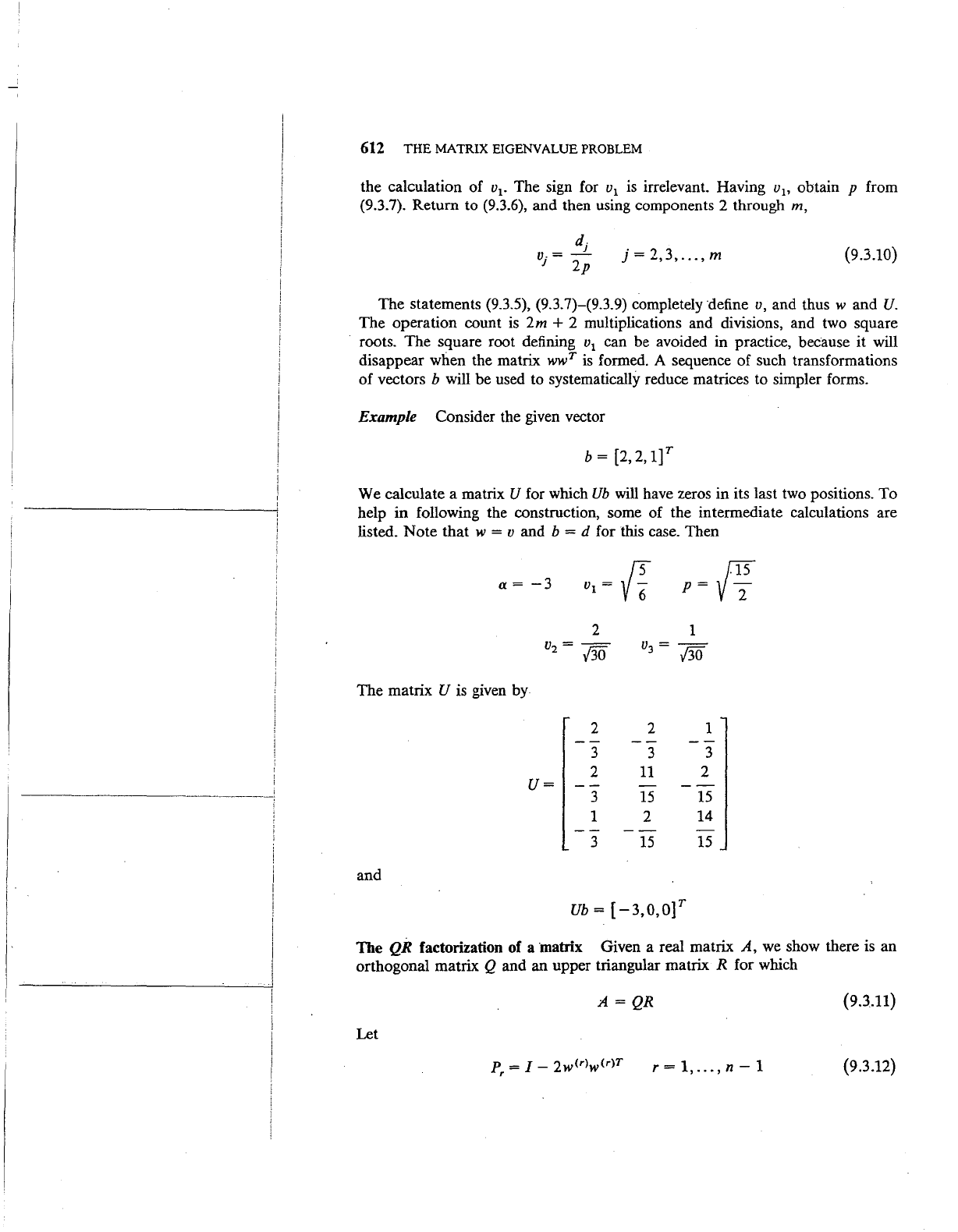
612
THE
MATRIX EIGENVALUE PROBLEM
the calculation of v
1
•
The sign for v
1
is
irrelevant. Having v
1
,
obtain p from
(9.3.7). Return to (9.3.6), and then using components 2 through
m,
dj
v.=-
J
2p
j=2,3,
...
,m
(9.3.10)
The statements (9.3.5), (9.3.7)-(9.3.9) completely ·define v, and thus w and
U.
The operation count
is
2m
+ 2 multiplications and divisions, and two square
roots. The square root defining v
1
can be avoided in practice, because
it
will
disappear when the matrix
ww r
is
formed. A sequence of such transformations
of
vectors b will be used to systematically reduce matrices to simpler forms.
Example Consider the given vector
b
= (2,2,
If
We calculate a matrix U for which
Ub
will
have zeros in its last two positions.
To
help
in
following the construction, some of the intermediate calculations are
listed.
Note
that
w = v and b = d for this case. Then
a=
-3
p=~
2
u =
--
2130
The matrix U is given by
2
2
1
--
3
3
3
2
11
2
U=
--
-
3
15
15
1 2
14
-
3
15
15
and
ub = ( -3,o,of
The
QR
factorization of a ·matrix Given a real matrix A, we show there is an
orthogonal matrix
Q and an upper triangular matrix R for which
A
=QR
(9.3.11)
Let
P
=I-
2w<r>w<r)T
r
r = 1,
...
, n
-1
(9.3.12)
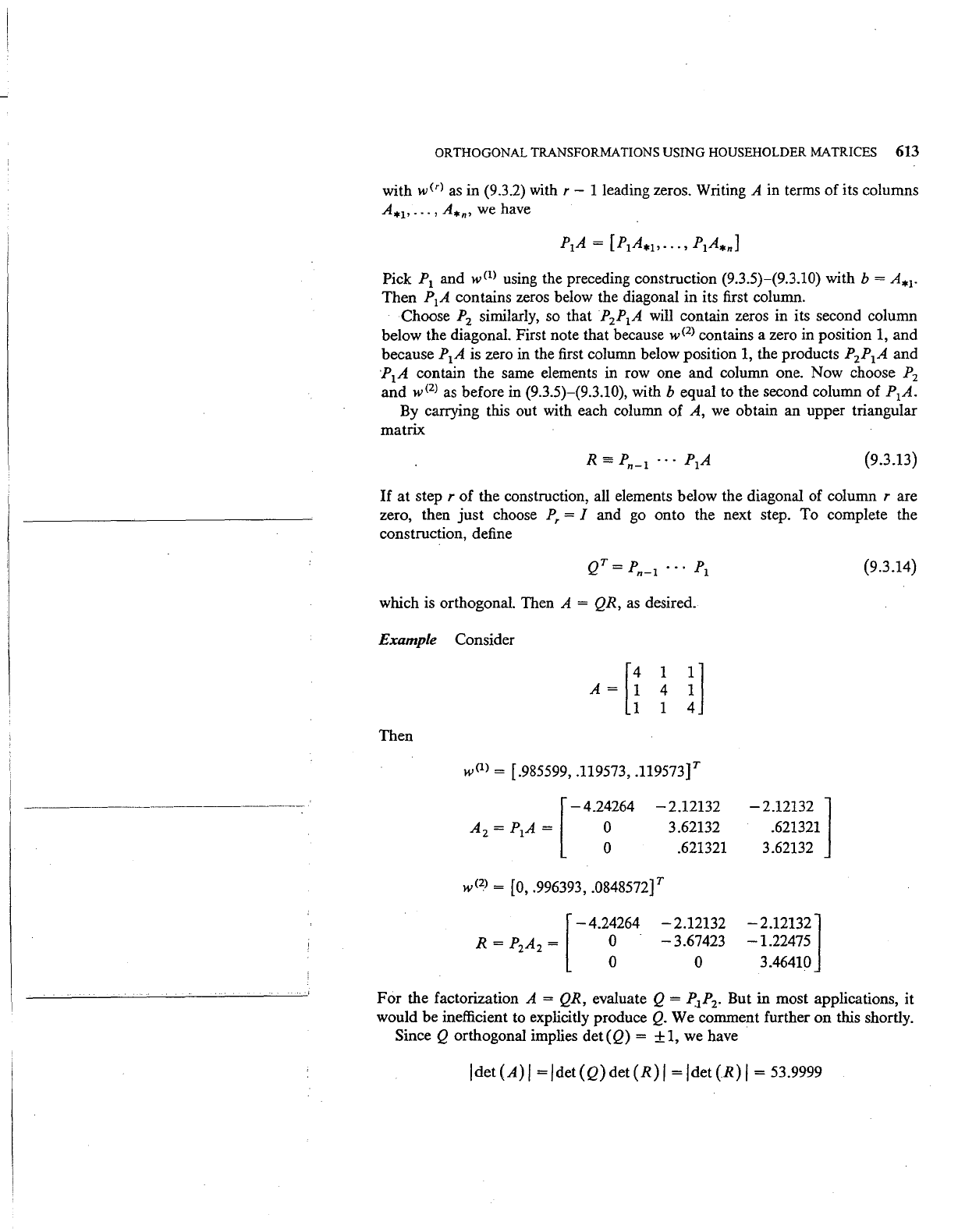
ORTHOGONAL TRANSFORMATIONS
USING
HOUSEHOLDER MATRICES 613
with
w<rl
as
in (9.3.2) with
r-
I leading zeros. Writing A in terms of its columns
A.
1
,
...
,
A*n'
we
have
Pick P
1
and
w<
1
> using the preceding construction (9.3.5)-(9.3.10) with b =
A.
1
.
Then P
1
A contains zeros below the diagonal in its first column.
Choose
P
2
similarly, so that P
2
P
1
A
will
contain zeros in its second column
below the diagonal. First note that because
w<
2
> contains a zero in position
1,
and
because
P
1
A is zero in the first column below position
1,
the products P
2
P
1
A and
P
1
A contain the same elements in row one and column one. Now choose P
2
and
w<
2
l
as
before in (9.3.5)-(9.3.10), with b equal to the second column of P
1
A.
By
carrying this out with each column of A,
we
obtain an upper triangular
matrix
(9.3.13)
If
at
step r of the construction, all elements below the diagonal of column r are
zero, then
just
choose
P,
= I and
go
onto the next step. To complete the
construction, define
which is orthogonal. Then
A = QR,
as
desired.
Example Consider
Then
1
4
1
!]
w<
1
> = [.985599, .119573, .119573]T
-2.12132
3.62132
.621321
w<
2
l = [0, .996393,
.0848572r
-2.12132
-3.67423
0
-2.12132
]
.621321
3.62132
-2.12132]
-1.22475
3.46410
(9.3.14)
For
the factorization A = QR, evaluate Q =
P.1P
2
•
But
in
most applications, it
would be inefficient
to
explicitly produce
Q.
We comment further on this shortly.
Since Q orthogonal implies
det(Q)
=
±1,
we have
ldet(A)I
=ldet(Q)det(R)I
=ldet(R)I
= 53.9999
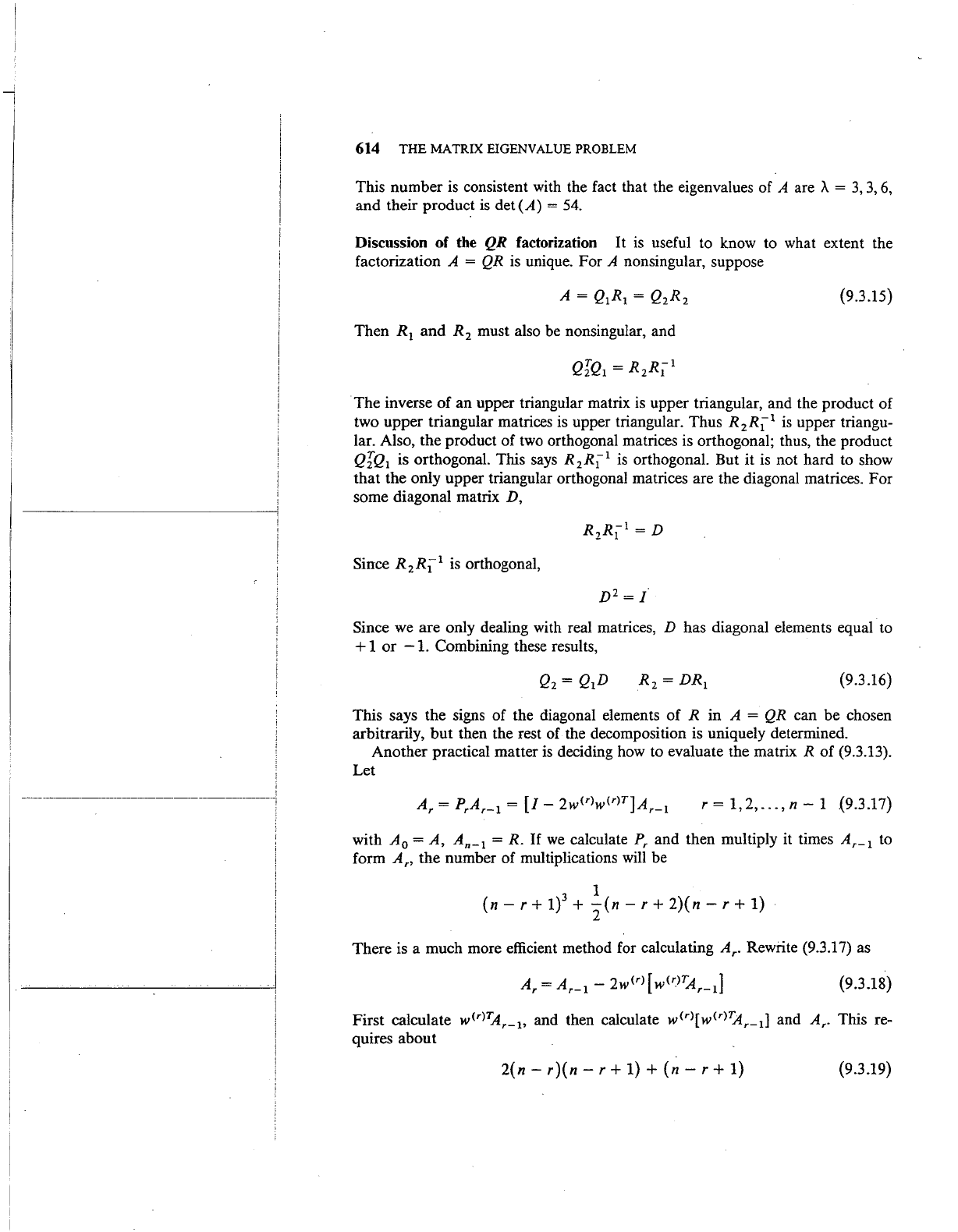
614
THE
MATRIX EIGENVALUE PROBLEM
This number
is
consistent with the fact that the eigenvalues of A are
A.
=
3, 3,
6,
and their product
is
det
(A)
= 54.
Discussion
of
the QR factorization
It
is
useful to know to what extent the
factorization
A = QR is unique. For A nonsingular, suppose
(9.3.15)
Then
R
1
and R
2
must also be nonsingular, and
·The inverse of an upper triangular matrix
is
upper triangular, and the product of
two upper triangular matrices is upper triangular. Thus
R
2
R1
1
is
upper triangu-
lar. Also, the product of
two
orthogonal matrices is orthogonal; thus, the product
QfQ
1
is orthogonal. This says R
2
R1
1
is
orthogonal. But it
is
not hard to show
that the only upper triangular orthogonal matrices are the diagonal matrices. For
some diagonal matrix
D,
Since R
2
R1
1
is
orthogonal,
Since we are only dealing with real matrices, D has diagonal elements equal to
+ 1
or
- 1. Combining these results,
{9.3.16)
This says the signs of the diagonal elements of
R in A = QR can be chosen
arbitrarily,
but
then the rest of the decomposition is uniquely determined.
Another practical matter
is
deciding
how
to evaluate the matrix R of (9.3.13).
Let
A =
PA
=
(J-
2w<'lw<rlT)A
r r r-1 r-1
r =
1,2,
...
,
n-
1 (9.3.17)
with
A
0
=
A,
An_
1
=
R.
If
we
calculate
P,
and then multiply
it
times
A,_
1
to
form
A,,
the number of multiplications
will
be
3 1
(n-
r +
1)
+
2(n-
r +
2)(n-
r + 1)
There is a much more efficient method for calculating
A,.
Rewrite (9.3.17)
as
A
=A
- 2w(r)
[w<r)TA
]
r
r-1
r-1
(9.3.18)
First calculate
w<r)TA,_
1
,
and then calculate w<'l[w<r)TA,_d and
A,.
This re-
quires about
2(n-
r)(n-
r +
1)
+
(n-
r +
1)
(9.3.19)
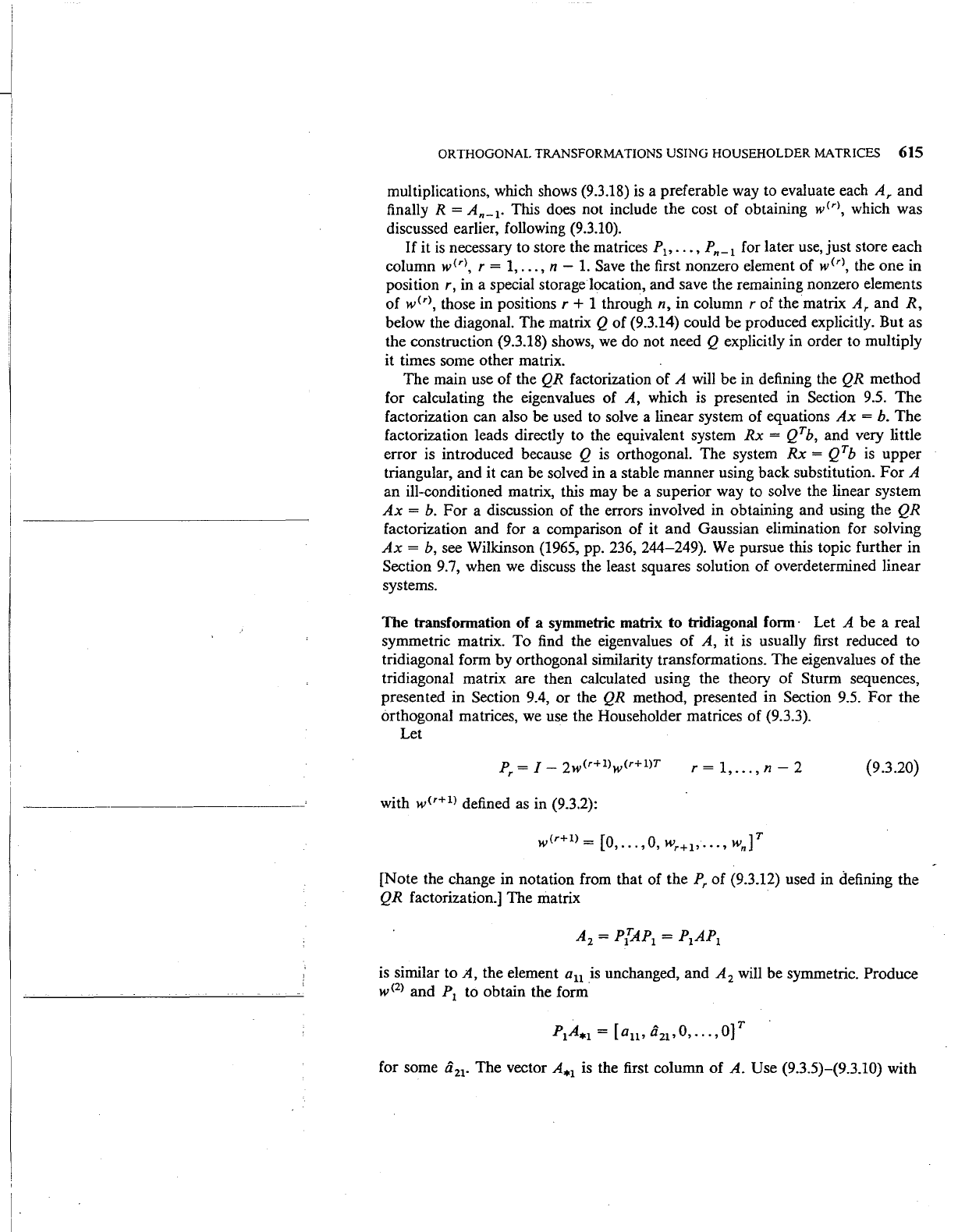
-------·----
I.
I
ORTHOGONAL TRANSFORMATIONS USING HOUSEHOLDER MATRICES 615
multiplications, which shows
(9.3.18)
is
a preferable
way
to evaluate each
Ar
and
finally R
=An-I·
This does not include the cost of obtaining
w<r>,
which was
discussed earlier, following
(9.3.10).
If
it
is
necessary to store the matrices PI,
...
,
Pn-I
for later
use,
just store each
column
w<r>,
r =
1,
...
, n -
1.
Save
the first nonzero element of
w<r>,
the one in
position
r, in a special storage location, and save the remaining nonzero elements
of
w<r>,
those in positions r + 1 through
n,
in column r of the matrix
Ar
and
R,
below the diagonal. The matrix Q of (9.3.14) could be produced explicitly. But as
the construction
(9.3.18) shows,
we
do not need Q explicitly in order to multiply
it
times some other matrix.
The main use of the
QR factorization of A
will
be in defining the QR method
for calculating the eigenvalues of
A, which
is
presented in Section
9.5.
The
factorization can also be used to solve a linear system of equations
Ax
= b. The
factorization leads directly to the equivalent system
Rx
= QTb, and very little
error
is
introduced because Q
is
orthogonal. The system
Rx
= QTb
is
upper
triangular, and
it
can be solved in a stable manner using back substitution.
For
A
an ill-conditioned matrix, this may be a superior way to solve the linear system
Ax
=
b.
For a discussion of the errors involved in obtaining and using the QR
factorization and for a comparison of it
and
Gaussian elimination for solving
Ax=
b,
see Wilkinson (1965, pp. 236, 244-249).
We
pursue this topic further in
Section 9.7, when
we
discuss the least squares solution of overdetermined linear
systems.
The transformation of a symmetric matrix to tridiagonal
form· Let A be a real
symmetric matrix. To find the eigenvalues of
A, it
is
usually first reduced to
tridiagonal form by orthogonal similarity transformations. The eigenvalues of the
tridiagonal matrix are then calculated using the theory of Sturm sequences,
presented in Section
9.4, or the QR method, presented in Section 9.5. For the
orthogonal matrices,
we
use the Householder matrices of (9.3.3).
Let
r =
1,
...
,
n-
2
(9.3.20)
with
w<r+
I)
defined as in (9.3.2):
(r+
I)
_ [0 0 ] T
w - ,
...
,
'wr+l,
...
,
wn
[Note the change in notation from that of the
Prof
(9.3.12) used in defining the
QR factorization.] The matrix
is
similar to A, the element a
11
is
unchanged, and A
2
will be symmetric. Produce
w<
2
> and PI to obtain the
form.
for some a
2
I.
The vector
A*I
is the first column
of
A. Use (9.3.5)-(9.3.10) with
